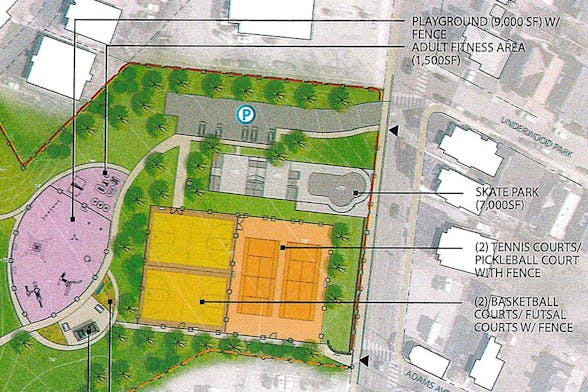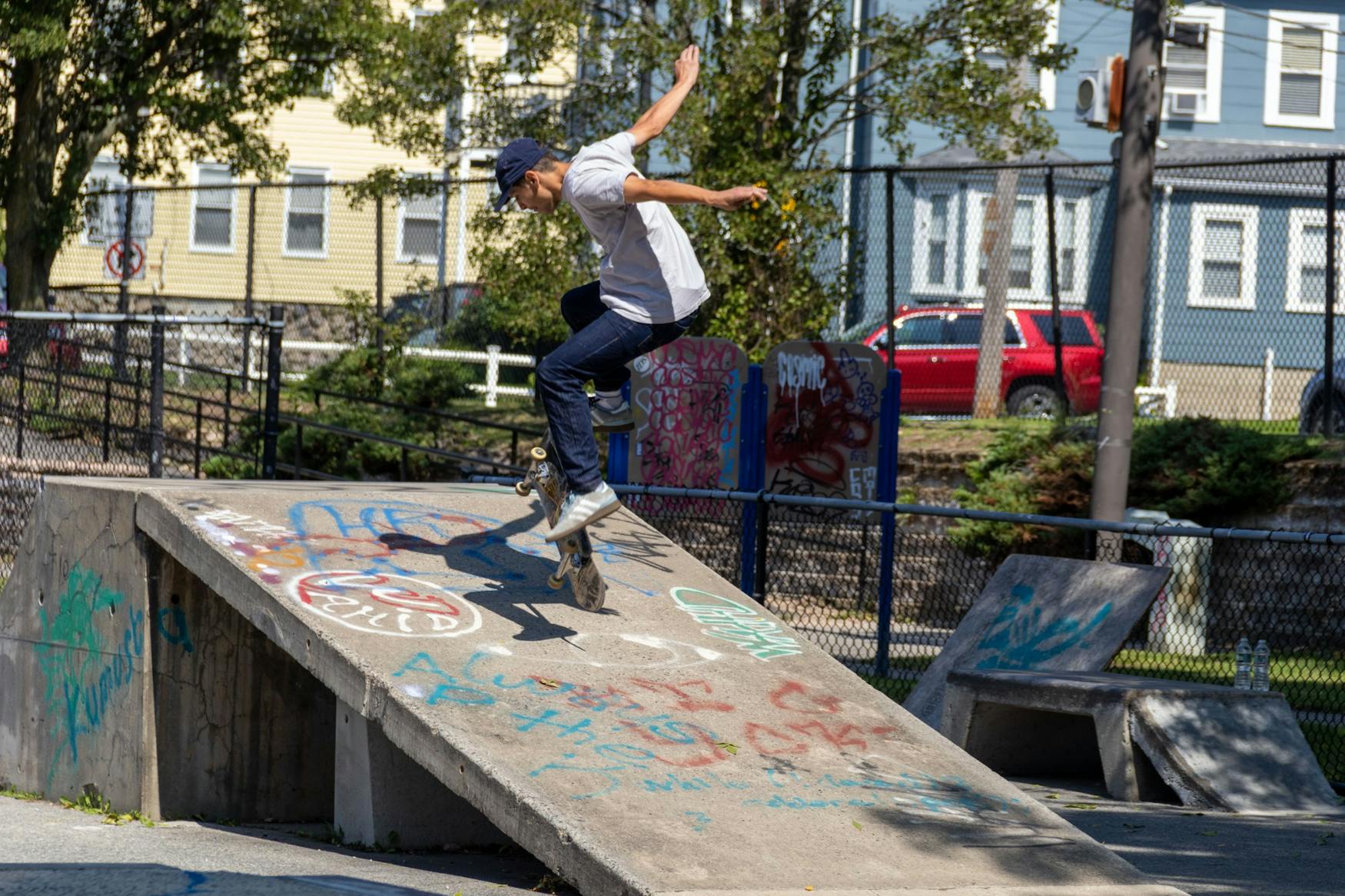Waltham skaters ‘ollie’ into advocacy for a better skatepark
A proposed plan to downsize the Waltham Skatepark led to a push from a tight-knit community of local skaters to ensure their voices were heard. The Justice spent the afternoon of Sept. 17 at the park to learn more.
At around 3 p.m. on a sunny Saturday afternoon, the Waltham Skatepark at Jack Koutoujian Playground is the place to be. Some skaters hang out next to the half pipe. Others stand atop the ramp on the opposite side of the park with their boards hanging over the edge. They watch their fellow skaters attempt tricks, hyping them up and offering tips as they wait to “drop in” for a turn.
The energy is exactly what Brian Daly, a veteran skater of 20-plus years and a fixture in the Waltham skate community, values so much about the park.
“You could be skating with an eighth-grader and a 40-year-old … you have this beautiful, relatable thing in common,” he said in a Sept. 16 video interview with the Justice.

ORGANIZER: Brian Daly has led the push from Waltham skaters to get the City to revise its plans for the new skatepark.
When the City of Waltham released its plans to allocate over $4 million dollars of federal funds to completely re-do the Jack Koutoujian Playground on Waltham’s South Side — promising an open green space with new basketball courts, tennis courts, two dog parks, and a completely redone skate park — city officials likely weren’t expecting much pushback. Approved by the Waltham Council in 2019, the plans to renovate the park mirrored taxpayer desires, according to Ward Eight City Council member Cathyann Harris. “The skateboard park will get completely redesigned … [there’s] a lot of support for that, Harris stated in an interview with the Waltham Newswatch, published Sept. 1. Harris said the layout of the skatepark “is not fully designed,” in a Sept. 19 email to the Justice.
To Daly, the plans the City initially published reflected a lack of thought by city officials toward the skaters who gather at the park. The plans included downsizing the skatepark from 11,400 to 7,000 square feet. The City did not ask the skaters for any input about what the new park should include before creating these plans.
“The place is already jam-packed with kids. [Now,] it’s going to be the size of a basketball court?” Daly said of the plans.

DOWNSIZE: The plans the City of Waltham released include a new skatepark, almost 4,500 square feet smaller than the current one.
When he’s not at the skatepark, Daly works as a social media strategist. At the end of 2020, he started @walthamboardpark, an Instagram account where he posts pictures and videos taken by him and other skaters at the park. For the past two years, the account has been a way for Daly to combine his social media skills with his love of the Waltham skater community. Now, it’s proven an effective platform for organizing.
In recent weeks, he has used the account as a place to push for the City to make skaters’ voices heard in the planning process for the new skatepark. The account’s bio now includes a link to a Facebook group fellow skater Eric Taranto created earlier this month. The goal of the group is to show the City of Waltham how important the skatepark is to the local community, in hopes that the City will make changes to the current plan “before creating a park that skaters won’t use,” according to the group’s “About’’ section.
Skaters have been using the group as a forum to discuss the City’s plans for the park and the changes they would like to see. Many have also shared fond memories of the skatepark, which first opened in 2000.

HALFPIPE HANGOUT: Nicky Shafer (center) said there's no judgement at the Waltham Skatepark. She's made lots of good friends at the park, mostly other high schoolers.
“Skateboarding is in the Olympics,” Daly said. “It’s the fastest growing sport in the world … why not realize that if you invest in skateboarding, you could have Olympic athletes coming out of Waltham?” In fact, Daly said, a professional skateboarder already has: Ryan Gallant grew up skating in Waltham. He has been sponsored by a variety of skateboard and skate apparel brands, is featured in multiple skating video games, and reportedly has a move named after him — the “Gallant Grind.”
On Sept. 2, a day after the Waltham Newswatch released their interview with Councilmember Harris about the City’s plan to redo the park, WCAC-TV published an article that called the park “declining,” and described the skatepark as “cover[ed]” in trash and graffiti. “They made it seem like the park was shitty and unused,” Daly said. This frustrated Daly, who said that he used @walthamboardpark to organize bi-weekly skate park cleanups in the summer and that the local skater community looks out for the park.
WCAC did not respond to a request for comment.
Daly said starting last year, several skaters applied for permits to allow those with repair work experience to fix the issues themselves. The City of Waltham denied the permits, citing liability concerns and the planned renovations down the line, Daly said. He explained that cracks in the cement of a skate park are a safety hazard, and with each passing winter, the ice that forms within them causes them to expand.

HAZARD: Cracks are a common feature at Waltham Skatepark. Brian Daly explained that they a hazard for skaters, who have started doing repairs themselves despite the city refusing to grant permits to allow this.
Without support from the City, skaters began their own “guerilla repairs” — crowdfunding money to fund nighttime cement patching, done by an anonymous skater — to ensure the safety of their community. “It’s part of the process for us,” Daly said about the community-led maintenance.
Tyler Meyer, a Brighton resident and a regular at the skatepark, was aware of the unpermitted repairs. “The only people who take care of it are the people that actually use the park,” he told the Justice at the park on Sept. 17.
In the last week, the ongoing social media outreach by skaters to the City has led to communication between skaters and city council members.
In a follow-up interview with the Justice on Sept. 18, Daly said recent meetings with Harris sparked discussion about the potential for a revised plan that would extend the skatepark by 20 feet on each side. Daly said he and Taranto, the other skater, had set up future weekly meetings with Harris to ensure that the Waltham skate community continues to have a say in the plans as they progress.
“She looks at me and Eric as big assets,” Daly said, “... We’re going to present an additional blueprint for the park expansion, so it’s possible we could get it bigger.”
Daly plans on continuing to use @walthamboardpark to gain input from the community. “All we want to do is make a park that provides a better experience for the next generation of skaters,” he said.
Meyer said the skatepark and the people who use it keep him coming out to Waltham. “I wouldn’t spend money at businesses here if it wasn’t for the park … all the people here are super nice and welcoming and there’s a great community,” he said. “I know for a fact that a lot of kids come out here because they have difficult home lives. It’s nice they have a community of people who welcome them.”

DIY: Tyler Meyer, who lives in Brighton, knew about fellow skaters doing work to repair issues at the Waltham Skatepark. “[The City of Waltham] doesn’t spend any time or effort taking care of this place. The only people who take care of it are the people that actually use the park."
On the other side of the park, Nicky Shafer stood on top of one of the park’s tallest ramps, preparing to “drop in” and give a trick she’d been working on another try. Shafer started skating at Waltham Skatepark two years ago; it was the first park she ever skated at. She said she’s made lots of friends at the park, and she never feels judged skating there.
She was the only girl at the park that day. This is usually the case, Shafer said in a Sept. 18 Instagram interview with the Justice, adding, “[It] kinda sucks ’cause it’s nice to have more girls, but hopefully more [will] come out.”
Next to Shafer stood Matt Schnorr, a friend of Daly’s who has been skating at the Waltham Skatepark for over 20 years. He teaches private skateboarding lessons at the park to almost a dozen people. His students range in age from 4 to 51 years old. “It’s a whole life down here,” he told the Justice. As Shafer steadied her board, Schnorr gave her some tips for her next attempt.

TIPS: Matt Schnorr, right, gave Nicky Shafer, some advice to help her land a trick she was working on.
Daly had gone to an urgent care clinic earlier that day to get his wrist looked at. The day before, he fell and injured himself at the park. Schnorr said Daly tried to keep skating after the fall, but even the slightest movement hurt his wrist. Yet, the next afternoon, Daly was back at the park. With a blue brace on his right wrist, he got on his board to do a trick every now and then. He spent the majority of the time filming other skaters, cheering them on when they successfully — or almost — landed a trick.
As the afternoon continued, skater Graham Oppenheimer sat against the half-pipe chatting with a group of friends, including Daly. While others hopped up every few minutes to ride around the park and try tricks, Oppenheimer stayed on the ground, holding a bag of ice on his knee. He’d hurt it doing a trick earlier that day. He said he hoped it felt better by sundown so he could keep skating.

THE SCENE: "The skate scene at Waltham brings so many people from so many walks of life together," 21-year-old skater and construction-worker Graham Oppenheimer said. At the park on Sept. 17, he alternated between icing his injured knee and doing tricks on his board.
Not long after, he got up and skated some ramps and banks with his friends. Every few minutes, he went back to icing his clearly still-injured knee.
Oppenheimer is a regular at the Waltham Skatepark. The park itself isn’t in very good condition, he said, but he and his fellow Waltham skaters endure these issues because of the community they’ve found: “There’s a reason we keep coming back here.”
— Justice editor Natalie Kahn contributed to the reporting of this story.




Please note All comments are eligible for publication in The Justice.